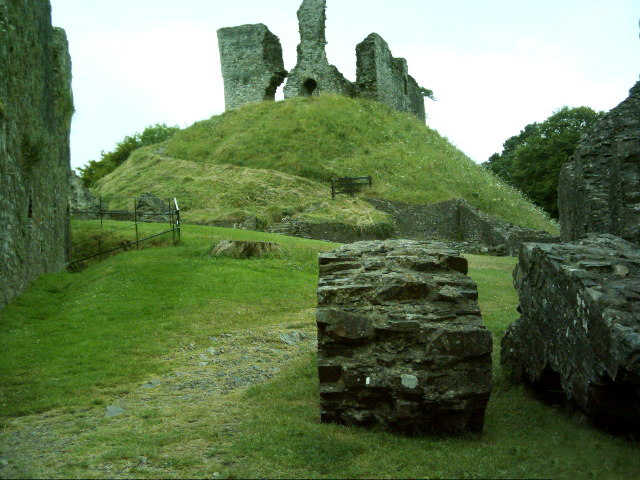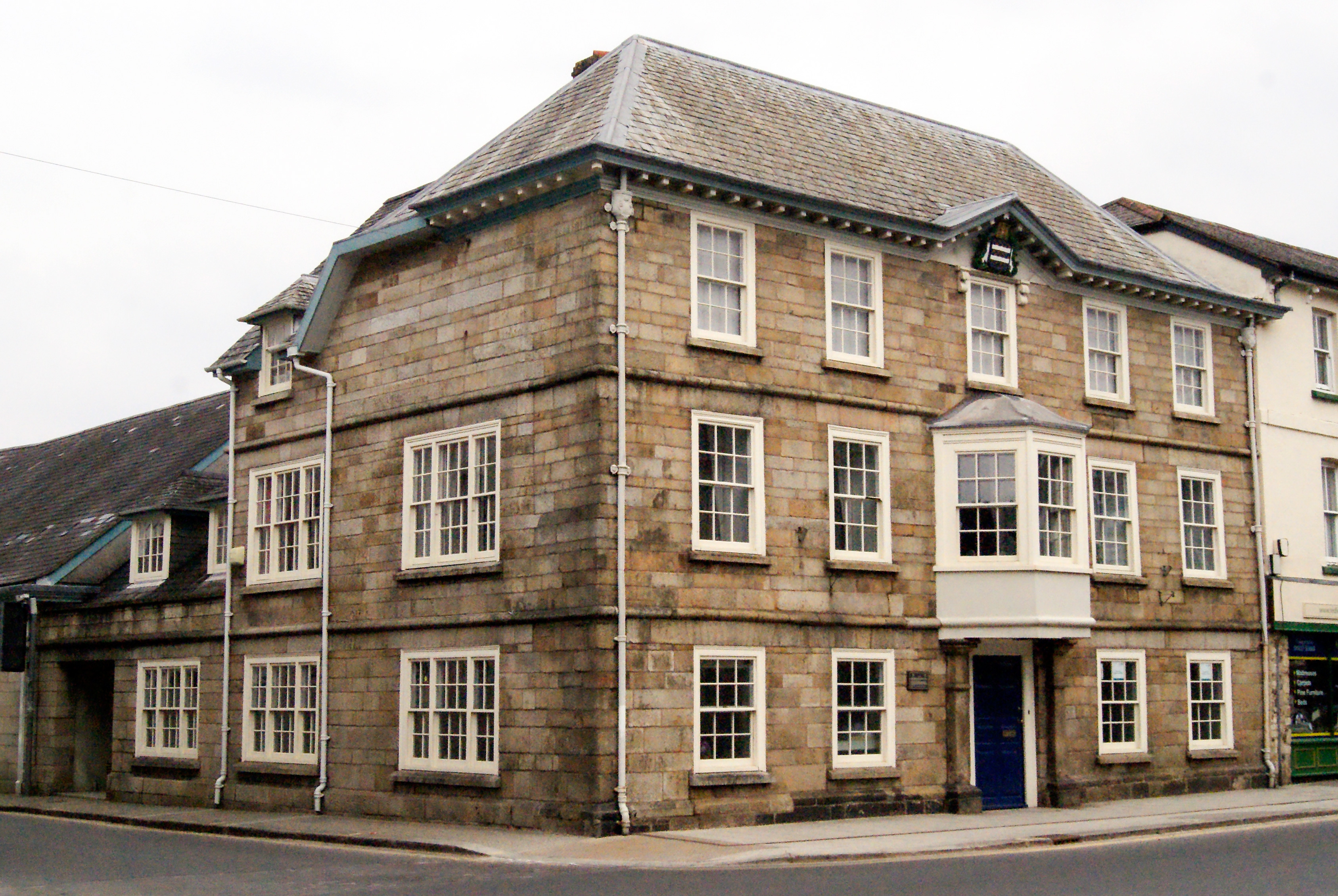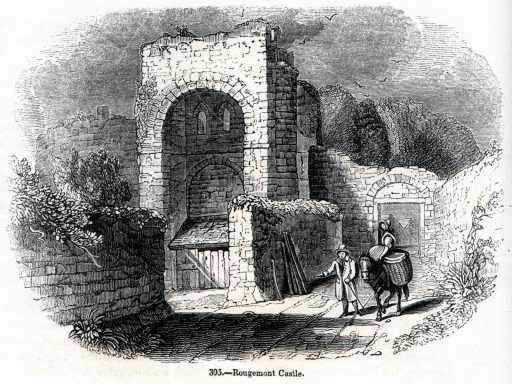|
Okehampton Castle
Okehampton Castle is a medieval motte and bailey castle in Devon, England. It was built between 1068 and 1086 by Baldwin FitzGilbert following a revolt in Devon against Norman rule, and formed the centre of the Honour of Okehampton, guarding a crossing point across the West Okement River. It continued in use as a fortification until the late 13th century, when its owners, the de Courtenays, became the Earls of Devon. With their new wealth, they redeveloped the castle as a luxurious hunting lodge, building a new deer park that stretched out south from the castle, and constructing fashionable lodgings that exploited the views across the landscape. The de Courtenays prospered and the castle was further expanded to accommodate their growing household. The de Courtenays were heavily involved in the 15th century Wars of the Roses and Okehampton Castle was frequently confiscated. By the early 16th century the castle was still in good condition, but after Henry Courtenay was executed ... [...More Info...] [...Related Items...] OR: [Wikipedia] [Google] [Baidu] |
Okehampton
Okehampton ( ) is a town and civil parishes in England, civil parish in West Devon in the English county of Devon. It is situated at the northern edge of Dartmoor, and had a population of 5,922 at the 2011 census. Two electoral wards are based in the town (east and west). Their joint population at the same census was 7,500. Okehampton is 21 miles (33 km) west of Exeter, 26 miles (42 km) north of Plymouth and 24 miles (38 km) south of Barnstaple. History Okehampton was founded by the Saxons. The earliest written record of the settlement is from 980 AD as , meaning settlement by the Ockment, a river which runs through the town. It was recorded as a place for slaves to be freed at cross roads. Like many towns in the West Country, Okehampton grew on the medieval wool trade. Notable buildings in the town include the 15th century chapel of James, son of Zebedee, St. James and Okehampton Castle, which was established by the Normans, Norman High Sheriff of Devon, Sherif ... [...More Info...] [...Related Items...] OR: [Wikipedia] [Google] [Baidu] |
William The Conqueror
William I; ang, WillelmI (Bates ''William the Conqueror'' p. 33– 9 September 1087), usually known as William the Conqueror and sometimes William the Bastard, was the first House of Normandy, Norman List of English monarchs#House of Normandy, king of England, reigning from 1066 until his death in 1087. A descendant of Rollo, he was Duke of Normandy from 1035 onward. By 1060, following a long struggle to establish his throne, his hold on Normandy was secure. In 1066, following the death of Edward the Confessor, William invaded England, leading an army of Normans to victory over the Anglo-Saxons, Anglo-Saxon forces of Harold Godwinson at the Battle of Hastings, and suppressed subsequent English revolts in what has become known as the Norman Conquest. The rest of his life was marked by struggles to consolidate his hold over England and his continental lands, and by difficulties with his eldest son, Robert Curthose. William was the son of the unmarried Duke Robert I of Normandy ... [...More Info...] [...Related Items...] OR: [Wikipedia] [Google] [Baidu] |
William De Redvers, 5th Earl Of Devon
William de Redvers, 5th Earl of Devon (died 10 September 1217) (or de Reviers), of Tiverton Castle and Plympton Castle, both in Devon, was feudal baron of Plympton in Devon. Origins He was the son of Baldwin de Redvers, 1st Earl of Devon by his wife Adelize Ballon. William de Redvers is also known as William de Vernon, because he was brought up at Vernon Castle, in Normandy, the seat of his grandfather Richard de Redvers. Career In 1194, De Redvers took part in the second coronation of King Richard the Lionheart (1189-1199), when the Canopy was supported by four Earls. He was a firm supporter of Richard's younger brother and heir King John (1199-1216), but after John's death, he permitted Falkes de Breauté, one of his mercenary captains, to seize De Redvers' widowed daughter-in-law, force a marriage, and take her dowry. These events are featured in Alfred Duggan's novel, ''Leopards and Lilies'' (1954). Marriage and issue He married Mabel de Beaumont, a daughter of Robert de B ... [...More Info...] [...Related Items...] OR: [Wikipedia] [Google] [Baidu] |
Renaud De Courtenay
Renaud de Courtenay, (d. 1190) anglicised to Reginald I de Courtenay, of Sutton, Berkshire, was a French nobleman of the House of Courtenay who took up residence in England and founded the English Courtenay family, who became Earls of Devon in 1335. The title is still held today, by his direct male descendant. Origins He was the son of Miles (Milo) de Courtenay, Seigneur (lord of the manor) of Courtenay, in the Kingdom of France, today in the Loiret department in north-central France, by his wife Ermengard de Nevers. Career Renaud succeeded his father as Seigneur of Courtenay. He fought in the Second Crusade, with King Louis VII of France. He quarrelled with King Louis VII, who seized Renaud's French possessions and gave them along with Renaud's daughter Elizabeth to his youngest brother, Pierre (Peter) of France, who thenceforth became known as Peter I of Courtenay (died 1183). Renaud became Lord of the Manor of Sutton in 1161. Marriages *(1) Hélène (Hawise) du Donjon, daughte ... [...More Info...] [...Related Items...] OR: [Wikipedia] [Google] [Baidu] |
The Anarchy
The Anarchy was a civil war in England and Normandy between 1138 and 1153, which resulted in a widespread breakdown in law and order. The conflict was a war of succession precipitated by the accidental death of William Adelin, the only legitimate son of King Henry I, who drowned in the sinking of the ''White Ship'' in 1120. Henry sought to be succeeded by his daughter, known as Empress Matilda, but was only partially successful in convincing the nobility to support her. On Henry's death in 1135, his nephew Stephen of Blois seized the throne, with the help of Stephen's brother Henry of Blois, who was the bishop of Winchester. Stephen's early reign saw fierce fighting with disloyal English barons, rebellious Welsh leaders, and Scottish invaders. Following a major rebellion in the south-west of England, Matilda invaded in 1139 with the help of her half-brother Robert of Gloucester. In the initial years of civil war, neither side was able to achieve a decisive advantage; the ... [...More Info...] [...Related Items...] OR: [Wikipedia] [Google] [Baidu] |
Castle-guard
Castle-guard was an arrangement under the feudal system, by which the duty of finding knights to guard royal castles was imposed on certain manors, knight's fees or baronies. The greater barons provided for the guard of their castles by exacting a similar duty from their sub-enfeoffed knights. The obligation was commuted very early for a fixed money payment, a form of scutage known as "castle-guard rent", which lasted into modern times.AL Poole, ''Domesday Book to Magna Carta'' (OUP, 2nd edition, 1955) Castle-guard was a common form of feudal tenure, almost ubiquitous, on the Isle of Wight where all manors were held from the Lord of the Isle of Wight, seated at Carisbrook Castle Carisbrooke Castle is a historic motte-and-bailey castle located in the village of Carisbrooke (near Newport), Isle of Wight, England. Charles I was imprisoned at the castle in the months prior to his trial. Early history The site of Carisbro .... References {{DEFAULTSORT:Castle-Guard Castle ... [...More Info...] [...Related Items...] OR: [Wikipedia] [Google] [Baidu] |
Ford (crossing)
A ford is a shallow place with good footing where a river or stream may be crossed by wading, or inside a vehicle getting its wheels wet. A ford may occur naturally or be constructed. Fords may be impassable during high water. A low-water crossing is a low bridge that allows crossing over a river or stream when water is low but may be treated as a ford when the river is high and water covers the crossing. Description A ford is a much cheaper form of river crossing than a bridge, and it can transport much more weight than a bridge, but it may become impassable after heavy rain or during flood conditions. A ford is therefore normally only suitable for very minor roads (and for paths intended for walkers and horse riders etc.). Most modern fords are usually shallow enough to be crossed by cars and other wheeled or tracked vehicles (a process known as "fording"). Fords may be accompanied by stepping stones for pedestrians. The United Kingdom has more than 2,000 fords, and most ... [...More Info...] [...Related Items...] OR: [Wikipedia] [Google] [Baidu] |
Okehampton Castle (14722992259)
Okehampton Castle is a medieval motte and bailey castle in Devon, England. It was built between 1068 and 1086 by Baldwin FitzGilbert following a revolt in Devon against Norman rule, and formed the centre of the Honour of Okehampton, guarding a crossing point across the West Okement River. It continued in use as a fortification until the late 13th century, when its owners, the de Courtenays, became the Earls of Devon. With their new wealth, they redeveloped the castle as a luxurious hunting lodge, building a new deer park that stretched out south from the castle, and constructing fashionable lodgings that exploited the views across the landscape. The de Courtenays prospered and the castle was further expanded to accommodate their growing household. The de Courtenays were heavily involved in the 15th century Wars of the Roses and Okehampton Castle was frequently confiscated. By the early 16th century the castle was still in good condition, but after Henry Courtenay was executed ... [...More Info...] [...Related Items...] OR: [Wikipedia] [Google] [Baidu] |
Montacute Castle
Montacute Castle was a castle built on a hill overlooking the village of Montacute, Somerset, England. Details Montacute Castle was built after the Norman Conquest of England in 1066 by Robert of Mortain. The castle was part of a new settlement called ''Mons Acutus'' - literally, sharp hill - built on land that Robert had acquired from Athelney Abbey in exchange for the manor of Purse Caundle, an expensive exchange for Robert. The natural features of the hill were used to form an oval-shaped motte and an inner bailey, surrounded by an outer bailey beyond.Richardson, p.7. A park for hunting was established alongside the castle and the village. The location for the castle is thought to have been a deliberate political statement by Robert: before the battle of Hastings, the Anglo-Saxons had discovered what they believed to be a holy cross on the hill. Taken into battle by Harold Godwinson who held it in great esteem, "the holy cross" had also been used as the battle cry of the Ang ... [...More Info...] [...Related Items...] OR: [Wikipedia] [Google] [Baidu] |
Castle Neroche
Castle Neroche is a Norman motte-and-bailey castle on the site of an earlier hill fort in the parish of Curland, near Staple Fitzpaine, Somerset, England. It is a Scheduled Ancient Monument. Location The hill rises to on the northern escarpment of the Blackdown Hills. The area is part of a site covered by a landscape partnership, known as the Neroche Scheme which is establishing trails and a public forest. It is managed by Forestry England and supported by the Heritage Lottery Fund and local organisations. History The origin of the term Neroche is believed to be a contraction of the Old English words ''nierra'' and ''rechich'' or ''rachich'' for Rache, a type of hunting-dog used in Britain in the Middle Ages, giving a meaning of the ''camp where hunting dogs were kept''. This also gives the site its alternative name of Castle Rache. Iron Age The reason for the construction of Iron Age hill forts has been a subject of debate. It has been argued that they could have been mi ... [...More Info...] [...Related Items...] OR: [Wikipedia] [Google] [Baidu] |
Caput
Latin words and phrases {{Short pages monitor ... [...More Info...] [...Related Items...] OR: [Wikipedia] [Google] [Baidu] |
Exeter Castle
Rougemont Castle, also known as Exeter Castle, is the historic castle of the city of Exeter, Devon, England. It was built into the northern corner of the Roman city walls starting in or shortly after the year 1068, following Exeter's rebellion against William the Conqueror. In 1136 it was besieged for three months by King Stephen. An outer bailey, of which little now remains, was added later in the 12th century. The castle is mentioned in Shakespeare's play ''Richard III'' in a reference to that king's visit to Exeter in 1483. Devon's county court was located here from at least 1607, and the three Devon Witches—the last people in England to be executed for witchcraft—were tried and convicted at the Exeter Assizes in 1682. All the buildings inside the walls were swept away in the 1770s to make way for a new courthouse, which was extended by the addition of wings in 1895 and 1905. Because of its function as a court, the interior of the castle was not open to the public unti ... [...More Info...] [...Related Items...] OR: [Wikipedia] [Google] [Baidu] |







